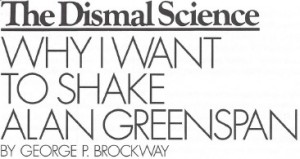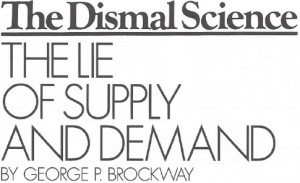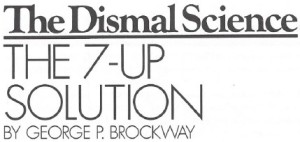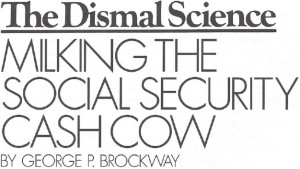By George P. Brockway, originally published November 3, 1997
As WE MOVE from welfare-as-we-knew-it to welfare-as-we-have-never-known-it, an often acrimonious debate is continuing between those who contend that the change will be most effective if the beneficiaries are motivated by a carrot and those who favor a stick. The press simplifies the story by calling the carrot people liberals and the stick people conservatives.
Actually, this is a very old debate. It went on during the years of AFDC (Aid to Families with Dependent Children), and it is going on in our time of TANF (Temporary Assistance to Needy Families). Both sides remain supported by innumerable anecdotal or imaginative reports and by many elaborate sociological studies, complete with chi-squares, regression analyses and multicolored graphs.
Welfare has generally been understood to be temporary, because the economic system has conventionally been understood to be evolving toward perfection. AFDC was envisioned as helping both poor widows and deserted mothers through a personal hard time. Many voters were surprised when it appeared that the distress of millions of families was caused by economic hard times that persisted, not only in the big cities but also in the countryside. Many more voters were angered when the late George Wylie’s Welfare Rights Organization and others, including some government officials, worked to inform distressed families of the help available to them. Still more voters became choleric as careless teenage girls and shiftless older women were said. (although the evidence was scanty) to make a living by producing babies while their male friends used welfare checks to tide themselves over when the drug-dealing or car-jacking business was slow. Hence TANF, with its lifetime limitations on welfare benefits, and the other restrictive provisions of the 1996 law, signed by the President amid a show of determination to fix it when he got a chance.
It does not take much imagination to see that little, if anything, has been accomplished. Let us suppose that there are women willing to make babies in order to stay on welfare. How are we going to stop them? We can, to be sure, reduce or cut off their benefits, but their children, who certainly did not originate their own births, will be the ones most hurt, as has happened in starvation situations in all cultures and all times.
Or are we going to turn children out in the streets, copying the culture of Calcutta? Or shall we take the children away from their mothers and put them, as some politician (I forgot who) suggested, in orphanages-preferably, no doubt, orphanages run for profit? What, then, becomes of family values?
Family values, of course, are only a couple of political catchwords that no one bothers to define. Nevertheless, one must wonder what is so important in our civilization that it requires putting children in orphanages or driving them into the street in order to punish the mothers. And will the presumably selfish mothers even feel the pain of the punishment being meted out?
The most enthusiastic advocates on the draconian side of the debate estimate that a high but unspecified percentage of welfare mothers will respond as intended to the stick approach-that they will seek and perform menial labor for substandard wages. This is nothing for civilized people to be proud of.
Assuming the expectation is correct, moreover, we will still have a considerable percentage of women pursuing their procreative ways. We might have their tubes tied, but the Supreme Court is apt to consider this a violation of the Eighth Amendment’s “cruel and unusual punishment” clause. Amending the Amendment is not likely to appeal either to those upholding the Right to Life or to those defending the Right to Choose-which pretty much covers the voting spectrum. On the other hand, there is evidence that the carrot approach sometimes encourages welfare dependency.
The foregoing is hardly a summary of a small part of the debate, many of whose arguments go back to Hammurabi of Babylon, Solon of Athens, Solomon of Judea, Jesus of Nazareth, Cato of Rome, and (perhaps most notably) to England’s long wrestle with the Poor Laws. The last dragged on from Elizabethan times until 1929, when the Local Government Act changed the name, but not the nature, of the trouble. I make bold to suggest that the terms of the debate are all wrong, and that we shall be not be able to solve the welfare conundrum unless we revise them.
As ALMOST ALWAYS happens in sociology, and far too frequently happens in economics, we are asked what is the: most efficient or cost-effective solution. Efficiency and cost-effectiveness, however, are at best secondary aspects where the lives of people are involved. For instance, the drug problem, however you want to define it, is considered one of the most serious facing America today. The vast majority of voters would probably place it ahead of welfare motherhood, and many would list it as a cause of welfare motherhood. Yet there is a recent example of an efficient and cost-effective solution that not even the most absolute American drug hater proposes we adopt.
For more than a hundred years after the Opium War (1839-42), in which the British forced China to allow the importation of opium, China was the typical case of the drug-plagued land. The opium dens of Shanghai and Canton were celebrated in fact and fiction. Mao Zedong’s People’s Republic wiped out the plague almost overnight. It was very simple. Every apartment house or neighborhood or farm had a committee dedicated to uncovering enemies of the people. Drug users and dealers were designated enemies. A few public trials (denunciations, actually) were held in athletic stadiums, followed forthwith by public executions. Other suspects were given the option of quitting cold turkey or being shot. Formal proof was unnecessary; suspicion was enough to trigger the option.
Despite this well-known bit of recent history, we do not rush to emulate it. We refrain for many reasons. The principal reason is that, with us, crimes deserving punishment must be proved in a court of law.
The Chinese solution was effective because judgment was summary and incontestable. That the sentence was capital speeded things up. A lighter sentence would have required more prisons or more chain gangs or more pillories, and especially more time to demonstrate to everyone that this particular crime did not pay. With us, justice is more important than effectiveness, efficiency or expense.
 Although you would never realize it from the way we talk or the way we write in our newspapers and magazines and textbooks, justice is also more important to us in economics than is effectiveness, efficiency or expense. Why else should we have abolished (to take the most vivid examples) slavery and child labor? To be sure, we had to fight a civil war to abolish slavery, and it wasn’t until 1938-eight years into the Great Depression that we were able to get a child labor law through a Southern-dominated Congress and past a states’ rights Supreme Court. But we finally managed to bring about both reforms, and neither one depended on considerations of effectiveness, efficiency or expense.
Although you would never realize it from the way we talk or the way we write in our newspapers and magazines and textbooks, justice is also more important to us in economics than is effectiveness, efficiency or expense. Why else should we have abolished (to take the most vivid examples) slavery and child labor? To be sure, we had to fight a civil war to abolish slavery, and it wasn’t until 1938-eight years into the Great Depression that we were able to get a child labor law through a Southern-dominated Congress and past a states’ rights Supreme Court. But we finally managed to bring about both reforms, and neither one depended on considerations of effectiveness, efficiency or expense.
For many years we were apparently ashamed of what we had done. It was said that slavery had become unprofitable, and that it would have died out anyway, sooner rather than later. It was also argued that most slaves were well cared for because they were worth good money, and that slave labor was really more expensive than free labor. The quasi-Marxian conclusion of these claims was that the true force behind abolition was the profit motive, not the brotherhood of man. No one raised the question of why it was thought necessary to abolish by law, let alone by force of arms, what was economically unprofitable. Perhaps the invisible hand did not quite work the way Adam Smith had said it did.
The child labor problem was not too different. Economists call all labor a “disutility.” Although few defended, say, having half-naked children (and their mothers) scramble on all fours like stunted donkeys to drag carts of coal through constricted mine drifts, market forces did not work against such atrocities because they were cost-effective.
In short, the fundamental economic problems are not solved-do not even exist-on so-called economic grounds. Efficiency and cost-effectiveness are not standards of right conduct. They are not primary rules for the good economy or the good life.
The thing about primary rules of right conduct is that they are not absolute, as 7+5=12 is absolute. They are local, for a time and place. They are historical. For a few obvious examples, we note that only recently has a 35-hour week come to be considered a full-time job. The 40-hour week was a goal 60 years ago, and our forefathers talked of working from sun to sun.
Likewise, what constitutes decent living conditions has changed and continues to change. The first public housing built by the New Deal had to exclude interior plumbing, not because of the cost, but because private housing of the time and place ordinarily lacked it.
Insofar as the length of the workweek and conditions of living are standards, they have nothing to do with either carrots or sticks. It is barbarous to apply the carrot-or-stick metaphor to human beings. Human beings are not a means to an end; we are all ends in ourselves. It is in this basic sense that we are all equal equally absolute and absolutely equal.
Rousseau said the state exists to force men to be free, but such force is vicious if the state does not also guarantee the opportunity to exercise freedom. Workfare as we now know it does not guarantee that opportunity, and so must resort to carrots and sticks to trick or beat donkeys into line.
Workfare will fail to meet the needs of our democratic society until it is guided by these two principles: First, the right of every citizen to make a contribution to the common weal-that is, to have a decent job-is equal to the state’s right to hold him or her to obedience to its laws.
Second, any full-time job that does not provide a decent and honorable living is not worth being done except as a favor or a hobby, as training or as punishment, or in defense of the realm.
The New Leader
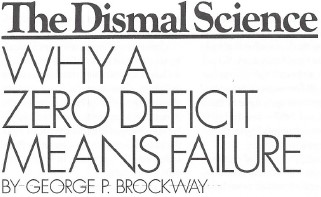 I DON’T want to alarm anyone, but I think it important for us to realize that the United States of America is about to sail into unfamiliar waters. What is more, those waters are inaccurately charted.
I DON’T want to alarm anyone, but I think it important for us to realize that the United States of America is about to sail into unfamiliar waters. What is more, those waters are inaccurately charted. Greenspan replied that he did not know enough about the people Jackson mentioned to use them as a basis for policy, but he acknowledged that they exist. His acknowledgment is my scoop for this week. For I submit that an economy incapable of providing proper jobs for 15 or 20 per cent of its work force is not an adequate economy. It may be “prosperous,” but it does not come close to doing what an economy ought to do. So we have a fourth crosscurrent to reckon with as we approach the waters whose charts are questionable.
Greenspan replied that he did not know enough about the people Jackson mentioned to use them as a basis for policy, but he acknowledged that they exist. His acknowledgment is my scoop for this week. For I submit that an economy incapable of providing proper jobs for 15 or 20 per cent of its work force is not an adequate economy. It may be “prosperous,” but it does not come close to doing what an economy ought to do. So we have a fourth crosscurrent to reckon with as we approach the waters whose charts are questionable.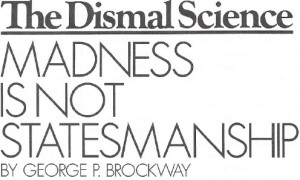 I SUBMIT that it’s time to give it up, quit, call a halt, put an end to the nonsense and the grief it has caused. The charade has had a run of almost 30 years. That is surely long enough for any group of people to toy with the wealth, health and happiness of their fellows.
I SUBMIT that it’s time to give it up, quit, call a halt, put an end to the nonsense and the grief it has caused. The charade has had a run of almost 30 years. That is surely long enough for any group of people to toy with the wealth, health and happiness of their fellows. As the natural rate theories began to unfold, their beauty, not to say elegance, began to be appreciated. For, look you: If there is a natural rate of unemployment, the most difficult and most important questions of economics-those that have to do with people-are answered. Better, they’re made to disappear; there’s no point in asking them.
As the natural rate theories began to unfold, their beauty, not to say elegance, began to be appreciated. For, look you: If there is a natural rate of unemployment, the most difficult and most important questions of economics-those that have to do with people-are answered. Better, they’re made to disappear; there’s no point in asking them.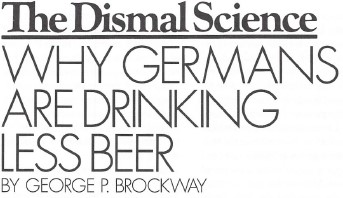 WELL, IT LOOKS as though Europe’s central bankers have blown it. The rest of us may rejoice. The Socialist victory means that France will no longer try to destroy its economy in order to qualify for admission to the European System of Central Banks, which is supposed to administer
WELL, IT LOOKS as though Europe’s central bankers have blown it. The rest of us may rejoice. The Socialist victory means that France will no longer try to destroy its economy in order to qualify for admission to the European System of Central Banks, which is supposed to administer 